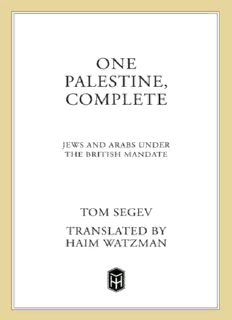
One Palestine, Complete: Jews and Arabs Under the British Mandate PDF
Preview One Palestine, Complete: Jews and Arabs Under the British Mandate
The author and publisher have provided this e-book to you for your personal use only. You may not make this e-book publicly available in any way. Copyright infringement is against the law. If you believe the copy of this e-book you are reading infringes on the author’s copyright, please notify the publisher at: us.macmillanusa.com/piracy. CONTENTS Title Page Copyright Notice Maps Introduction: Until We Meet Again PART I: ILLUSION (1917–27) 1. Khalil al-Sakakini Receives a Visitor 2. “A Contract with Jewry” 3. Self-Service 4. Ego Versus Ego 5. Between Mohammed and Mr. Cohen 6. Nebi Musa, 1920 7. A Steady Gaze and a Firm Jaw 8. Jaffa, 1921 9. Culture Wars 10. Yefim Gordin Comes to Palestine 11. A New Man 12. Negotiations with Friends PART II: TERROR (1928–38) 13. The Nerves of Jerusalem 14. Hebron, 1929 15. Breakfast at Chequers 16. Hamlet in Bir Zeit 17. Khalil al-Sakakini Builds a Home 18. Made in Palestine 19. The Story of a Donkey 20. Ireland in Palestine PART III: RESOLUTION (1939–48) 21. Hunting Season 22. “Give Me a Country Without Wars” 23. The Last Salute Notes Acknowledgments Index Also by Tom Segev Praise for One Palestine, Complete About the Author Copyright Introduction: Until We Meet Again On the southern slopes of Mount Zion, alongside the ruins of biblical Jerusalem, lies a small Protestant cemetery. The path to it wends through pines and cypresses, olive and lemon trees, oleander bushes in pink and white, leading to a black iron gate around which curls an elegant grapevine. Perhaps a thousand graves are scattered over the terraced hill; ancient stones peer out from among red anemones. Not far away, on the top of the mountain, is a site Jews revere as the grave of King David as well as a room in which Catholics say the Last Supper was held; in a nearby basement chamber, they believe, eternal sleep fell over Mary, mother of Jesus. The Muslims have also sanctified several tombs on the mountain. Bishop Samuel Gobat consecrated the cemetery in the 1840s to serve a small community of men and women who loved Jerusalem. Few had been born in the city; the great majority came as foreigners, from almost everywhere between America and New Zealand. Engraved on their headstones are epitaphs in English and German, Hebrew, Arabic, and ancient Greek; one headstone is in Polish.1 When the first of the dead were interred here, Palestine was a rather remote region of the Ottoman Empire with no central government of its own and few accepted norms. Life proceeded slowly, at a pace set by the stride of the camel and the reins of tradition. Outsiders began to flock to the country toward the end of the century, and it then seemed to awake from its Levantine stupor. Muslims, Jews, or Christians, a powerful religious and emotional force drew them to the land of Israel. Some stayed only a short time, while others settled permanently. Together they created a magical brew of prophecy and illusion, entrepreneurship, pioneerism, and adventurism—a multicultural revolution that lasted almost a hundred years. The line separating fantasy and deed was often blurred—there were charlatans and eccentrics of all nationalities—but for the most part this period was marked by drive and daring, the audacity to do things for the first time. For a while the new arrivals were intoxicated by a collective delusion that everything was possible. An American brought the first automobile—that was in 1908. He traveled the length and breadth of the country and created a sensation. A Dutch journalist arrived in the Galilee, dreaming of teaching its inhabitants Esperanto. A Jewish educator from Romania opened a nursery school in Rishon LeTzion, a tiny experimental Zionist settlement, and was among the editors of the first Hebrew children’s newspaper. Someone began making ice cream—that was Simcha Whitman, who also built the first kiosk in Tel Aviv. A man named Abba Cohen established a fire department, and a Berlin-born entrepreneur built the first beehives. A Ukrainian conductor founded a local opera company, and an Antwerp businessman set up a diamond-polishing shop. A Russian agronomist who had studied in Zurich planted eucalyptus trees, and an industrialist from Vilna launched Barzelit, the first nail factory. A Russian physician, Dr. Aryeh Leo Boehm, set up the Pasteur Institute, and a man named Smiatitzki, who came from Poland, translated Alice in Wonderland into Hebrew.2 George Antonius, a prominent Palestinian Arab, dreamed of an Arab university and in the meantime sought funds to support the publication of an Arab dictionary of technological terms.3 Antonius had come to Jerusalem from Alexandria, Egypt. Others of the country’s Arabs had come from Turkey and Morocco, from Persia and Afghanistan, and from half a dozen other countries; there were also former black slaves who had escaped from their masters, or who had been freed.4 Tens of thousands of people, most of them Jews, came from Eastern and Central Europe. Among them were courageous rebels searching for a new identity, under the influence of Zionist ideology. Others had fled persecution or poverty; most came unwillingly, as refugees. A. D. Gordon, a white-bearded farmer-preacher, a kind of local Tolstoy, proclaimed a gospel of manual labor and return to nature in the Galilee. He had come from the Ukraine and was one of the fathers of labor Zionism, the political movement that led the Jews to
Description: